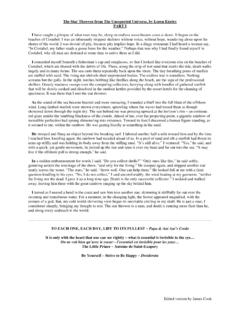Transcription of Pursuing Happiness: The Architecture of Sustainable Change
1 Pursuing Happiness: The Architecture of Sustainable ChangeSonja LyubomirskyUniversity of California, RiversideKennon M. SheldonUniversity of Missouri ColumbiaDavid SchkadeUniversity of California, San DiegoThe pursuit of happiness is an important goal for many people. However, surprisinglylittle scientific research has focused on the question of how happiness can be increasedand then sustained, probably because of pessimism engendered by the concepts ofgenetic determinism and hedonic adaptation. Nevertheless, emerging sources of opti-mism exist regarding the possibility of permanent increases in happiness. Drawing onthe past well-being literature, the authors propose that a person s chronic happinesslevel is governed by 3 major factors: a genetically determined set point for happiness,happiness-relevant circumstantial factors, and happiness-relevant activities and prac-tices.
2 The authors then consider adaptation and dynamic processes to show why theactivity category offers the best opportunities for sustainably increasing , existing research is discussed in support of the model, including 2 preliminaryhappiness-increasing pursuit of happiness holds an honoredposition in American society, beginning withthe Declaration of Independence, where it ispromised as a cherished right for all , the enduring obsession with how tobe happy can be observed in the row upon rowof popular psychology and self-help books inany major bookstore and in the millions ofcopies of these books that are sold.
3 Indeed,many social contexts in the United States havethe production of happiness and positive feel-ings as their primary purpose, and questionssuch as Are you happy? and Are you havingfun? fit nearly every occasion (Markus &Kitayama, 1994). Not surprisingly, the majorityof residents rate personal happiness as veryimportant (Diener, Suh, Smith, & Shao, 1995;Triandis, Bontempo, Leung, & Hui, 1990) andreport thinking about happiness at least onceevery day (Freedman, 1978). Furthermore, thepursuit of happiness is no longer just a NorthAmerican obsession, but instead it is becomingever more global as people seek to fulfill thepromises of capitalism and political freedom(Diener et al.)
4 , 1995; Freedman, 1978; Triandiset al., 1990). It seems that nearly all peoplebelieve, or would like to believe, that they canmove in an upward spiral (Sheldon & Houser-Marko, 2001) toward ever greater the pursuit of happiness merely a bourgeoisconcern, a symptom of Western comfort andself-centeredness, a factor that has no real im-pact on psychological adjustment and adapta-tion? The empirical evidence suggests that thisis not the case. Indeed, a number of researchersand thinkers have argued that the ability to behappy and contented with life is a central crite-rion of adaptation and positive mental health( , Diener, 1984; Jahoda, 1958; Taylor &Brown, 1988).
5 Bolstering this notion, Ly-ubomirsky and her colleagues recently com-Sonja lyubomirsky , Department of Psychology, Univer-sity of California, Riverside; Kennon M. Sheldon, Depart-ment of Psychology, University of Missouri Columbia;David Schkade, Rady School of Management, University ofCalifornia, San work was supported in part by grants from thePositive Psychology Network. We are grateful to LindaHouser-Marko, Kathleen Jamir, and Chris Tkach for con-ducting library research and to Shelley Taylor, David Sher-man, and the other members of Psychology 421 for valuablecomments on a concerning this article should be ad-dressed to Sonja lyubomirsky , Department of Psychology,University of California, Riverside, CA 92521, or KennonM.
6 Sheldon, Department of Psychological Sciences, 112 McAlester Hall, University of Missouri, Columbia, MO65211. E-mail: or of General PsychologyCopyright 2005 by the Educational Publishing Foundation2005, Vol. 9, No. 2, 111 1311089-2680/05/$ DOI: evidence showing that happiness has nu-merous positive byproducts that appear to ben-efit individuals, families, and communities( lyubomirsky , King, & Diener, 2004; see alsoFredrickson, 2001). Furthermore, Lyubomirskyet al. s analysis revealed that happy people gaintangible benefits in many different life domainsfrom their positive state of mind, includinglarger social rewards (higher odds of marriageand lower odds of divorce, more friends, stron-ger social support, and richer social interac-tions; , Harker & Keltner, 2001; Marks &Fleming, 1999; Okun, Stock, Haring, & Witter,1984), superior work outcomes (greater creativ-ity, increased productivity, higher quality ofwork, and higher income; , Estrada, Isen, &Young, 1994; Staw, Sutton, & Pelled, 1995),and more activity, energy, and flow ( , Csik-szentmihalyi & Wong, 1991).
7 Further supporting the argument that subjec-tive happiness may be integral to mental andphysical health, happy people are more likely toevidence greater self-control and self-regulatoryand coping abilities ( , Aspinwall, 1998;Fredrickson & Joiner, 2002; Keltner & Bon-anno, 1997), to have a bolstered immune system( , Dillon, Minchoff, & Baker, 1985; Stone etal., 1994), and even to live a longer life ( ,Danner, Snowdon, & Friesen, 2001; Ostir,Markides, Black, & Goodwin, 2000). Also,happy people are not just self-centered or self-ish; the literature suggests that happy individu-als instead tend to be relatively more coopera-tive, prosocial, charitable, and other-centered ( , Isen, 1970; Kasser & Ryan, 1996; Wil-liams & Shiaw, 1999).
8 In summary, happy individuals appear morelikely to be flourishing people, both inwardlyand outwardly. Thus, we argue that enhancingpeople s happiness levels may indeed be a wor-thy scientific goal, especially after their basicphysical and security needs are met. Unfortu-nately, however, relatively little scientific sup-port exists for the idea that people s happinesslevels can Change for the better. For example,the happiness-boosting techniques proposed inthe self-help literature generally have limitedgrounding in scientific theory and even lessempirical confirmation of their effectiveness(Norcross et al.)
9 , 2000). Consider a representa-tive best seller,You Can Be Happy No MatterWhat: Five Principles for Keeping Life in Per-spective,by Carlson (1997). Do the five princi-ples work? Do some work better than others?Do the principles work better for some peoplethan for others? Are any positive effects of theprinciples due, ultimately, to placebo effects? Ifthe book actually helps people get happier, does the happiness boostlast? Although it ispossible that some of the advice given in thisand other similar books could well be appropri-ate and effective, the authors provide almost noempirical research in support of their receives little more guidance from con-temporary academic psychology.
10 Of course, re-search psychologists have identified many pre-dictors of people s happiness or subjective well-being. For example, well-being has been shownto be associated with a wide variety of factors,including demographic status ( , Argyle,1999; Diener, Suh, Lucas, & Smith, 1999; My-ers, 2000), personality traits and attitudes ( ,Diener & Lucas, 1999), and goal characteristics( , McGregor & Little, 1998). However, alimitation of previous research is that the vastmajority of studies have been cross sectionaland have reported between-subjects effectsrather than investigating well-being longitudi-nally and examining within-subject effects.






